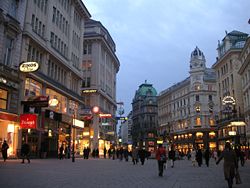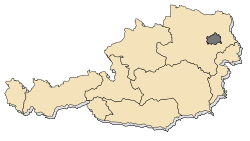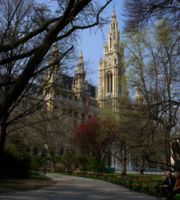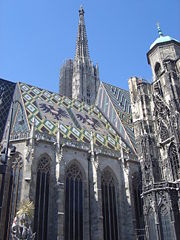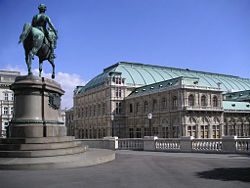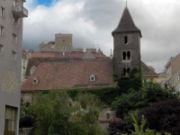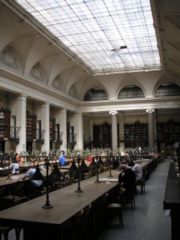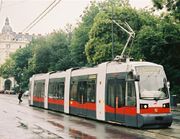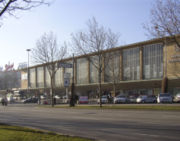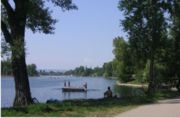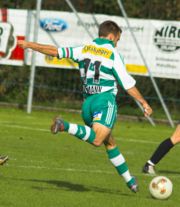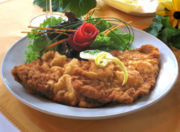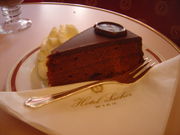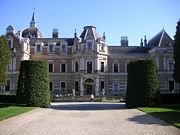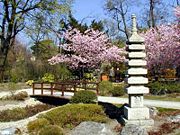Vienna
2008/9 Schools Wikipedia Selection. Related subjects: Europe; European Cities
| Vienna Wien |
|||
|
|||
| Location of Vienna in Austria | |||
| Coordinates: | |||
|---|---|---|---|
| State | Austria | ||
| Government | |||
| - Mayor | Michael Häupl ( SPÖ) | ||
| Area | |||
| - City | 414.90 km² (160.2 sq mi) | ||
| - Land | 395.51 km² (152.7 sq mi) | ||
| - Water | 19.39 km² (7.5 sq mi) | ||
| Population (2nd quarter of 2008) | |||
| - City | 1,680,447 | ||
| - Density | 4,011/km² (10,388.4/sq mi) | ||
| - Metro | 2,268,656 (01.02.2007) | ||
| Time zone | CET ( UTC+1) | ||
| - Summer ( DST) | CEST ( UTC+2) | ||
| Website: www.wien.at | |||
Vienna (in German Wien pronounced /viːn/; /viˈɛnʌ/ English; see also other names) is the capital of Austria, and is also one of the nine states of Austria. Vienna is Austria's primary city; with a population of about 1.7 million (2.3 million within the metropolitan area), it is by far the largest city in Austria as well as its cultural, economic and political centre. It is the 10th largest city by population in the European Union and was listed by Mercer Human Resource Consulting as having the 2nd highest quality of living (as of 2008). Vienna is host to many major international organizations such as the United Nations and OPEC. Vienna lies in the very east of Austria and is close to the Czech Republic, Slovakia and Hungary. In 2001, the city centre was designated a UNESCO World Heritage Site and an Economist Intelligence Unit study of 127 world cities ranked it first equal with Vancouver for the quality of life.
History
Founded around 500 BC, Vienna was originally a Celtic settlement. In 15 BC, Vienna became a Roman frontier city ( Vindobona) guarding the Roman Empire against Germanic tribes to the north.
Vienna came under threat from the Mongolian Empire that stretched over much of present day Russia and China in the 1200s. However, due to the death of its leader Genghis Khan, the Mongolian armies receded from the European frontier and were not to return.
During the Middle Ages, Vienna was home to the Babenberg Dynasty and in 1440 AD became residence city of the Habsburg dynasties from where Vienna eventually grew to become the capital of the Holy Roman Empire and a cultural centre for arts and science, music and fine cuisine. In the 16th and 17th centuries, the Ottoman armies were stopped twice outside Vienna (see Siege of Vienna, 1529 and Battle of Vienna, 1683).
In 1804, Vienna became capital of the Austrian Empire and continued to play a major role in European and World politics, including hosting the 1814 Congress of Vienna. After the Austro-Hungarian Compromise of 1867 Vienna remained the capital of what was then the Austro-Hungarian Empire. During the latter half of the 19th century the city developed what had previously been the bastions and glacis into the Ringstraße, a major prestige project. Former suburbs were incorporated, and the city of Vienna grew dramatically.
In 1918, after World War I, Vienna became capital of the First Austrian Republic. During the 1920s and 1930s it was a bastion of Socialism in Austria, and became known as " Red Vienna." The city was stage to the Austrian Civil War of 1934, when Chancellor Engelbert Dollfuss sent the Army to shell civilian housing occupied by the socialist militia. In 1938, after a triumphant entry into Austria, Adolf Hitler famously spoke to the Austrian people from the balcony of the Neue Burg, a part of the Hofburg at the Heldenplatz. Between 1938 (Anschluß) and the end of the Second World War, Vienna lost its status as a capital to Berlin.
In 1945, the Vienna Offensive was successfully launched by the Soviets against the Germans holding Vienna. The city was besieged for about two weeks before it fell to the Soviets. After 1945, Vienna again became the capital of Austria. It was initially divided into four zones by the 4 Powers and was governed by the Allied Commission for Austria. During the 10 years of foreign occupation Vienna became a hot-bed for international espionage between the Western and Eastern blocs.
In the 1970s Austrian Chancellor Bruno Kreisky inaugurated the creation of the Vienna International Centre, a new area of the city created to host international institutions. Vienna has regained a part of its former international relevance by hosting such international organizations as the United Nations ( UNIDO, UNOV, CTBTO and UNODC), the International Atomic Energy Agency, the Organization of Petroleum Exporting Countries, and the Organization for Security and Cooperation in Europe.
Historical population
Due to industrialization and immigration from other parts of the Empire, the population of Vienna increased sharply during its time as capital of Austria-Hungary (1867–1918). In 1910, Vienna had more than 2 million inhabitants and was one of the five largest cities in the world. However, after World War I, many Czechs and Hungarians returned to their ancestral countries, resulting in a decline in the Viennese population. At the height of the immigration, about one third of the people living in Vienna were of Slavic or Hungarian descent. By 2001, only 16% of people living in Vienna had nationalities other than Austrian, nearly half of which were from the former Yugoslavia; the next most numerous nationalities in Vienna were Turkish (39,000 or 2.5%), Polish (13,600 or 0.9%) and German (12,700 or 0.8%).
-
Year 1754 1800 1850 1900 1910 1923 1939 Total
population175,460 271,800 551,300 1,769,137 2,083,630 1,918,720 1,770,938 Year 1951 1961 1971 1981 1991 2001 2008 Total
population1,616,125 1,627,566 1,619,885 1,531,346 1,539,848 1,550,123 1,678,435
Geography and Climate
| Climate chart for Vienna | |||||||||||
|---|---|---|---|---|---|---|---|---|---|---|---|
| J | F | M | A | M | J | J | A | S | O | N | D |
|
38
2
-3
|
43
4
-2
|
40
9
3
|
50
14
5
|
61
19
9
|
73
22
13
|
63
25
15
|
58
25
15
|
45
21
12
|
40
14
6
|
50
7
2
|
43
4
-1
|
| temperatures in °C precipitation totals in mm source: weather.com |
|||||||||||
|
Imperial conversion
|
|||||||||||
Vienna lies in eastern Austria, at the easternmost extension of the Alps in the Vienna Basin. The earliest settlement, at the location of today's inner city, were south of the meandering Danube while the city now spans both sides of the river. Elevation ranges from 151 to 542 m.
Vienna has temperate climate with warm summers and cold winters. The average temperatures in the summer highs is into the mid 20s and overnight lows into the high 10s; although the winter highs are just above freezing and the overnight lows just below.
Districts
Vienna is composed of 23 districts (Bezirke). Legally, they are not districts in the sense of administrative bodies with explicit powers (such as the districts in the other Austrian states), but mere subdivisions of the city administration. Elections at the district level give the representatives of the districts some political power in fields such as planning and traffic.
The 23 districts are numbered for convenience in a roughly clockwise fashion starting in the city centre:
|
|
The heart and historical city of Vienna, the Innere Stadt, was once surrounded by walls and open fields in order to deny cover to potential attackers. The walls were razed in 1857, making it possible for the city to expand and eventually merge with the surrounding villages. In their place, a broad boulevard called the Ringstraße was built, along which imposing public and private buildings, monuments, and parks now lie. These buildings include the Rathaus (town hall), the Burgtheater, the University, the Parliament, the twin museums of natural history and fine art, and the Staatsoper. It is also the location of the Hofburg, the former imperial palace. The mainly Gothic Stephansdom is located at the centre of the city, on Stephansplatz. Beyond the Ringstraße, there was another wall called the Linienwall, which was torn down in the latter half of the 19th century to make room for expanding suburbs. It is now a ring road called Gürtel.
Industries are located mostly in the southern and eastern districts. The Innere Stadt is situated away from the main flow of the Danube, but is bounded by the Donaukanal ("Danube canal"). Vienna's second and twentieth districts are located between the Donaukanal and the Danube River. Across the Danube are the newest districts, which include the location of the Vienna International Centre.
Vienna's postal codes can be determined by the district where a given address is located; 1XXA - 1 denotes Vienna, XX the district number (if it is a single digit then with a leading zero), A is the number of the post office (irrelevant in this case, usually zero). Example: 1070 for Neubau. Exceptions include 1300 for the Vienna International Airport located in Lower Austria near Schwechat, 1400 for the UN Complex, 1450 for the Austria Centre, and 1500 for the Austrian UN forces.
Politics
Until 1918, Viennese politics were shaped by the Christian Social Party, in particular long-term mayor Karl Lueger. Vienna is today considered the centre of the Social Democratic Party of Austria. During the period of the First Republic (1918-1934), the Vienna Social Democrats undertook many overdue social reforms. At that time, Vienna's municipal policy was admired by Socialists throughout Europe, who therefore referred to the city as " Red Vienna" (Rotes Wien).
For most of the time since the First World War, the city has been governed by the Social Democratic Party with absolute majorities in the city parliament. Only between 1934 and 1945, when the Social Democratic Party was illegal, mayors were appointed by the austro-fascist and later by the Nazi authorities. The current mayor of Vienna is Michael Häupl. The Social Democrats currently hold 55% of the seats with a 49% share of the vote. Many Austrian political experts believe that if not for the Social Democrats' nearly unbreakable hold on Vienna, the rival Austrian People's Party would dominate Austrian politics.
An example of the city’s many social democratic policies is its low-cost residential estates called Gemeindebauten.
Ever since Vienna obtained federal state (Bundesland) status of its own in 1921, the mayor has also had the role of the state governor (Landeshauptmann). The Rathaus accommodates the offices of the mayor and the state government (Landesregierung). The city is administered by a multitude of departments (Magistratsabteilungen).
Religions
Vienna is the seat of the Viennese Roman Catholic archdiocese, and its acting Archbishop is Cardinal Christoph Schönborn. The religions of the Viennese resident population is divided according to the 2001 census as follows :
| Roman Catholic | 49.2% |
| No religion | 25.7% |
| Muslim | 7.8% |
| Orthodox | 6.0% |
| Protestant (mostly Lutheran) | 4.7% |
| Jewish | 0.5% |
| Other or none indicated | 6.3% |
Culture
| Historic Centre of Vienna* | |
|---|---|
| UNESCO World Heritage Site | |
|
|
|
| State Party | |
| Type | Cultural |
| Criteria | ii, iv, vi |
| Reference | 1033 |
| Region† | Europe |
| Inscription history | |
| Inscription | 2001 (25th Session) |
| * Name as inscribed on World Heritage List. † Region as classified by UNESCO. |
|

The Jugendstil Karlsplatz Stadtbahn Station by Otto Wagner
|
Music, theatre and opera
- Translated from here
Art and culture have a long tradition in Vienna, including theatre, opera, classical music and fine arts. The Burgtheater is considered one of the best theaters in the German-speaking world alongside its branch, the Akademietheater. The Volkstheater Wien and the Theatre in der Josefstadt also enjoy good reputations. There is also a multitude of smaller theaters, in many cases devoted to less mainstream forms of performing arts, such as modern, experimental plays or cabaret.
Vienna is also home to a number of opera houses, including the Staatsoper and the Volksoper, the latter being devoted to the typical Viennese operetta. Classical concerts are performed at well known venues such as the Wiener Musikverein, home of the Vienna Philharmonic Orchestra, and the Wiener Konzerthaus. Many concert venues offer concerts aimed at tourists, featuring popular highlights of Viennese music (particularly the works of Wolfgang Amadeus Mozart and Johann Strauss).
In recent years, the Theatre an der Wien has become widely known for hosting premieres of musicals, although it has recently devoted itself to the opera again. The most successful musical by far was " Elisabeth", which was later translated into several other languages and performed all over the world. The Haus der Musik ("house of music") opened in 2000.
Many Roman Catholic churches in central Vienna also feature performances of religious or other music, including masses sung with classical music and organ.
Museums
- Translated from here
The Hofburg is the location of the Schatzkammer (treasury), holding the imperial jewels of the Hapsburg dynasty. The Sisi Museum (a museum devoted to Empress Elisabeth Amalie Eugenie of Austria) allows visitors to view the Imperial apartments as well as the silver cabinet. Directly opposite the Hofburg are the Kunsthistorisches Museum and the Naturhistorisches Museum, which houses many paintings by old masters, ancient and classical artifacts.
A number of museums are located in the Museumsquartier (museum quarter), the former Imperial Stalls which were converted into a museum complex in the 1990s. It houses the Museum of Modern Art (Ludwig Foundation), the Leopold Museum (focusing on works of the Viennese Secession, Viennese Modernism and Austrian Expressionism), additional halls with feature exhibitions and the Tanzquartier. The Liechtenstein Palace contains one of the world's largest private art collections. There are a multitude of other museums in Vienna, including the Military History Museum, the Technical Museum, the Vienna Clock Museum and the Burial Museum. The museums dedicated to Vienna's districts provide a retrospective of the respective districts.
Architecture
- Translated from here
A variety of architectural styles can be found in Vienna, such as the Romanesque Ruprechtskirche and the Baroque Karlskirche. Styles range from classicist buildings to modern architecture. Art Nouveau left many architectural traces in Vienna. The Secession, Karlsplatz Stadtbahn Station, and the Kirche am Steinhof by Otto Wagner rank among the best known examples of Art Nouveau in the world.
The Hundertwasserhaus by Friedensreich Hundertwasser, designed to counter the clinical look of modern architecture, is one of Vienna's most popular tourist attractions. Another example of unique architecture is the Wotrubakirche by sculptor Fritz Wotruba.
In the 1990s, a number of quarters were adapted and extensive building projects were implemented in the areas around Donaustadt (north of the Danube) and Wienerberg (in southern Vienna). The 202 m-high Millennium Tower located at Handelskai is the highest building in Vienna. In recent years, Vienna has seen numerous architecture projects completed which combine modern architectural elements with old buildings, such as the remodelling and revitalisation of the old Gasometer in 2001.
Most buildings in Vienna are relatively low; there are currently (early 2006) around 100 buildings higher than 40 m. The number of high-rise buildings is kept low by building legislation aimed at preserving green areas and districts designated as world cultural heritage. Strong rules apply to the planning, authorisation and construction of high-rise buildings. Consequently, much of the inner city is a high-rise free zone.
Vienna Balls
Vienna is the last great capital of the nineteenth century ball. There are over 200 significant balls per year, some featuring as many as nine live orchestras. Balls are held in the many beautiful palaces in Vienna, with the principal venue being the Hofburg Palace at Heldenplatz. While the Opera Ball is the best known internationally of all the Austrian balls, other balls such as the Kaffeesiederball (Cafe Owners Ball), the Jägerball (Hunter's Ball) and the Rudolfina Redoute are almost as well known within Austria and even better appreciated for their cordial atmosphere. Most Viennese of even middle class visit at least a few balls in their lifetime. For many, the ball season lasts three months and can include up to ten or fifteen separate appearances.
Dancers and opera singers from the Vienna Staatsoper often perform at the openings of the larger balls.
A Vienna ball is an all night cultural attraction. Major Viennese balls generally begin at nine pm and last until five am, although many guests carry on the celebrations into the next day.
Education
Vienna is also Austria's main centre of education and home to many universities, professional colleges and gymnasiums.
Universities
- Academy of Fine Arts Vienna
- Diplomatic Academy of Vienna
- Medical University of Vienna
- PEF Private University of Management Vienna
- University of Applied Arts Vienna
- University of Natural Resources and Applied Life Sciences, Vienna
- University of Music and Performing Arts, Vienna
- University of Vienna
- University of Veterinary Medicine Vienna
- Vienna University of Economics and Business Administration
- Vienna University of Technology
- Webster University Vienna
- Internationales Kulturinstitut
International schools
- American International School Vienna
- Danube International School
- Vienna Christian School
- Vienna International School
- Lycée Francais de Vienne
- International University Vienna
Transportation
Twelve bridges cross the Danube in the city, which is divided by the Danube and its branch, the Neue Donau ("new Danube").
Public transportation
Vienna has a large public transportation network.
- Vienna S-Bahn
- Vienna U-Bahn
- Local Railways (Lokalbahn Wien-Baden)
- Wiener Linien (= Vienna Lines, municipal company operating U-Bahn, tram, and most bus routes)
Vienna has an extensive tram and bus network - the tram network being third largest in the world. In the most populated areas of Vienna, public transport runs so frequently (even during off-peak hours) that any familiarity with departure timetables is virtually unnecessary. The convenience and flexibility of the public transport is in turn reflected by its popularity; 53% of Viennese workers travel to their workplace by public transport. During night hours, public transport is continued by the Nightline buses operating on all the main routes, generally every half hour.
Fare prices within the city are independent of the length of the journey and covers all modes of public transport. Tickets are also available for various time periods, such as 24 hour, monthly or yearly tickets.
The Viennese public transport services are incorporated into a larger concentric system of transport zones, the VOR (Verkehrsverbund Ostregion = eastern region transport association). VOR includes railway and bus lines operating 50 kilometers into the surrounding areas, and ticket prices are calculated according to the number of zones crossed, Vienna being a single zone. Tickets must be purchased (and usually punched ) prior to boarding or entering a station. Tickets are not routinely checked when entering a station or boarding, but there are surprise inspections on all routes.
There are also two miniature railways: the Liliputbahn in the Wiener Prater and the Donauparkbahn in the Donaupark. They are for amusement purposes and have no practical importance as a means of public transport.
Railways
Historically, all transport was oriented towards the main cities in the Austro-Hungarian monarchy. Vienna has several train stations that form the beginning of several train lines:
- Wien Franz-Josefs-Bahnhof, the starting point of the Franz Josef Railway
- Wien Westbahnhof, starting point of the Western Railway
- Wien Südbahnhof (Former South and East Station) for the Southern Railway and the Eastern Railway
There are also several through train stations:
- Wien Hütteldorf on the Western Railway
- Wien Heiligenstadt on the Franz Josef Railway
- Wien Praterstern (Formerly known as Wien Nord or Wien Nord-Praterstern) on the Northern Railway.
- Wien Meidling (Philadelphiabrücke) on the Southern Railway. This is Vienna's most frequented transit station.
- Wien Mitte ( Landstraße) on the S-Bahn Stammstrecke ("main line") is the nearest railway station to the centre of Vienna.
There are also a large number of smaller stations that are important for local passenger traffic. Since the mid 1990s, the Westbahnhof and Südbahnhof have handled all long-distance travel. Many trains also stop at Hütteldorf or Meidling, especially when inbound.
In order to bundle all long-distance traffic it has become necessary to build a tunnel, colloquially known as the Wildschweintunnel ("boar tunnel"), underneath Lainzer Tiergarten linking the Western Railway to the Southern Railway. The new bundled train line will connect to a new through train station called Wien Zentralbahnhof that will be constructed instead of the Südbahnhof.
Road traffic
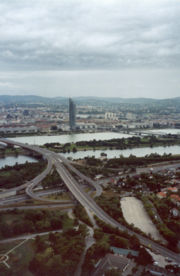
- To be translated from here
Similar to the train lines, Bundesstraßen leave the city in a star-shaped pattern. Some are named after their historical final destination (Prager Straße to Prague, Linzer Straße to Linz, Triester Straße to Trieste and Brünner Straße to Brno). Bundesstraßen can be compared to U.S. Highways in the United States, being two-lane in rural areas and multi-lane in urban areas........
Four national autobahns leave Vienna in the westerly ( A1), northwesterly (A22), southerly (A2), and easterly directions (A4). Similar to the rail lines, they are commonly referred to after their exit direction ( Westautobahn, Südautobahn, and Ostautobahn). In addition, several spur and branch autobahns circle around the southern and eastern areas of the city. The protected Wienerwald forest area in the western and northern areas has been left mostly untouched.
Air traffic
Vienna International Airport is located to the southeast of Vienna. The airport handled over 254,000 arrivals and departures in 2007 and was frequented by 18.77 million passengers. Following lengthy negotiations with surrounding communities, the airport will be expanded to increase its capacity by adding a third runway. The airport is currently undergoing a major expansion, including a new terminal building and office park, to prepare for an expected increase in passengers.
Water transportation
- To be translated from here
Vienna is connected to Rotterdam and German Industrial areas via the Rhine-Main-Danube Canal, and to Eastern European countries along the Danube to the Black Sea. The planned Danube-Oder-Canal remains unfinished.
The "Twin City Liner" boat service connects Vienna and Bratislava.
Nearly all of Vienna's drinking water is brought to the city via two large water pipelines, built in the late 19th and early 20th centuries. The pipelines stretch 120 km (75 miles) and 200 km (124 miles) from the Alps to the city's Hietzing district. The Alpine sources are pristine and the water does not require treatment.
Leisure activities
Viennese parks and gardens
Vienna possesses many park facilities, including the Stadtpark, the Burggarten, the Volksgarten (part of the Hofburg), the Schloßpark at Schloss Belvedere (home to the Vienna Botanic Gardens), the Donaupark, the Schönbrunner Schlosspark, the Prater, the Augarten, the Rathauspark, the Lainzer Tiergarten, the Dehnepark, the Resselpark, the Votivpark, the Kurpark Oberlaa, the Auer-Welsbach-Park and the Türkenschanzpark. Green areas include Laaer-Berg (including the Bohemian Prater) and the foothills of the Wienerwald, which reaches into the outer areas of the city. Small parks, known by the Viennese as Beserlparks, are everywhere in the inner city areas. Many of Vienna's famous parks include monuments, such as the Stadtpark with its statue of Johann Strauss II, and the gardens of the baroque palace, where the State Treaty was signed. Vienna's principal park is the Prater which is home to the Riesenrad, a ferris wheel. The imperial Schönbrunn's grounds contain an 18th century park which includes the world's oldest zoo, founded in 1752. The Donauinsel, part of Vienna's flood defences, is a 21.1 km long artificial island between the Danube and Neue Donau dedicated to leisure activities.
Sport
Vienna hosts many different sporting events including the Vienna City Marathon, which attracts more than 10,000 participants every year and normally takes place in May. In 2005 the Ice Hockey World Championships took place in Austria and the final was played in Vienna. Vienna's Ernst Happel Stadium was the venue of four Champions League and European Champion Clubs' Cup finals (1964, 1987, 1990 and 1995) and will host the final of Euro 2008.
Austria's capital is home to numerous teams. The best known are the local football clubs SK Rapid Wien (32 Austrian Bundesliga titles), FK Austria Wien (23 Austrian Bundesliga titles and 26-time cup winners) and the oldest team, First Vienna FC. Other important sport clubs include the Dodge Vikings Vienna (American Football), who won the Eurobowl title between 2004 and 2007 4 times in a row, the Vienna Hot Volleys, one of Europe's premier Volleyball organisations, and the Vienna Capitals (Ice Hockey).
Culinary specialities
Food
Vienna is well known for Wiener schnitzel, a cutlet of veal that is pounded flat, coated in flour, egg and breadcrumbs, and fried in clarified butter. It is available in almost every restaurant that serves Viennese cuisine. Other examples of Viennese cuisine include " Tafelspitz" (very lean boiled beef), which is traditionally served with " Geröstete Erdäpfel" (boiled potatoes mashed with a fork and subsequently fried) and horseradish sauce, "Apfelkren" (a mixture of horseradish, cream and apple) and "Schnittlauchsauce" (a chives sauce made with mayonnaise and old bread).
Vienna has a long tradition of cakes and desserts. These include Apfelstrudel (hot apple strudel), Palatschinken (sweet pancakes), and Knödel (dumplings) often filled with fruit such as apricots (Marillenknödel). Sachertorte, a dry chocolate cake with apricot jam from the Sacher Hotel, is world famous.
In winter, small street stands sell traditional Maroni (hot chestnuts) and potato fritters. Sausages are also popular and available from street vendors ("Würstelstand") throughout the night. The sausage known as Wiener (German for "Viennese") in the USA and Germany is however called a Frankfurter. Other popular sausages are Burenwurst (a coarse beef and pork sausage, generally boiled) and Käsekainer (spicy pork with small chunks of cheese).
The Naschmarkt is a permanent market for fruit, vegetables, spices, fish, meat and much more from around the world. The city centre has many speciality food stores, such as the " Julius Meinl am Graben".
Drink
Vienna, along with Paris, Prague and Bratislava, is one of the few remaining world capital cities with its own vineyards. The wine is served in small Viennese pubs known as Heuriger, which are especially numerous in the wine growing areas of Döbling ( Grinzing, Neustift am Walde, Nußdorf, Salmannsdorf, Sievering) and Floridsdorf ( Stammersdorf, Strebersdorf). The wine is often drunk as a spritzer ("G'spritzter") with sparkling water. The Grüner Veltliner, a dry white wine, is the most widely cultivated wine in Austria.
Beer is next in importance to wine. Vienna has a single large brewery, Ottakringer, and more than ten microbreweries. A "Beisl" is a typical small Austrian pub, of which Vienna has many.
Viennese cafés
Viennese cafés have an extremely long and distinguished history that dates back centuries, and the caffeine addictions of some famous historical patrons of the oldest are something of a local legend. Traditionally, the coffee comes with a glass of water. Viennese cafés claim to have invented the process of filtering coffee from bounty captured after the second Turkish siege in 1683. Viennese cafés claim that when the invading Turks left Vienna, they abandoned hundreds of sacks of coffee beans. The Emperor gave Franz George Kolschitzky (Polish - Franciszek Jerzy Kulczycki) some of this coffee as a reward for providing information that allowed the Austrians to defeat the Turks. Kolschitzky then opened Vienna's first coffee shop. Julius Meinl set up a modern roasting plant in the same premises where the coffee sacks were found, in 1891.
Tourist attractions
Major tourist attractions include the imperial palaces of the Hofburg and Schönbrunn (also home to the world's oldest zoo, Tiergarten Schönbrunn) and the Riesenrad in the Prater. Cultural highlights include the Burgtheater, the Wiener Staatsoper, the Lipizzaner horses at the spanische Hofreitschule and the Vienna Boys' Choir, as well as excursions to Vienna's Heuriger districts.
There are also more than 100 art museums, which together attract over eight million visitors per year. The most popular ones are Albertina, Belvedere, Leopold Museum in the Museumsquartier, KunstHausWien, BA-CA Kunstforum, the twin Kunsthistorisches Museum and Naturhistorisches Museum, and the Technisches Museum Wien, each of which receives over a quarter of a million visitors per year.
There are many popular sites associated with composers who lived in Vienna including Beethoven's various residences and grave at Zentralfriedhof (Central Cemetery) which is the largest cemetery in Vienna and the burial site of many famous people. Mozart has a memorial grave at the Hapsburg gardens and at St. Marx cemetery (where his grave was lost). Vienna's many churches also draw large crowds, the most famous of which are St. Stephen's Cathedral, the Deutschordenskirche, the Jesuitenkirche, the Karlskirche, the Peterskirche, Maria am Gestade, the Minoritenkirche, the Ruprechtskirche, the Schottenkirche and the Votivkirche.
Modern attractions include the Hundertwasserhaus, the United Nations headquarters and the view from the Donauturm.
International organizations in Vienna
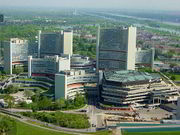
Vienna is the seat of a number of United Nations offices and various international institutions and companies, including the United Nations Industrial Development Organization (UNIDO), the Organization of Petroleum Exporting Countries (OPEC), the International Atomic Energy Agency (IAEA), the Preparatory Commission for the Comprehensive Nuclear-Test-Ban Treaty Organization (CTBTO) and the Organization for Security and Co-operation in Europe (OSCE). Additionally, Vienna is the seat of the United Nations Commission on International Trade Law's secretariat (UNCITRAL). In conjunction, the University of Vienna annually hosts the prestigious Willem C. Vis Moot, an international commercial arbitration competition for students of law from around the world.
Various special diplomatic meetings have been held in Vienna in the latter half of the 20th century, resulting in various documents bearing the name Vienna Convention or Vienna Document. Among the more important documents negotiated in Vienna are the 1969 Vienna Convention on the Law of Treaties, as well as the 1990 Treaty on Conventional Armed Forces in Europe (CFE).
Charitable organizations in Vienna
Alongside the international and intergovernmental organisations, there are dozens of charitable organisations based in Vienna; these organisations provide relief goods and assistance to tens of thousands of disadvantaged children and needy people in developing countries.
One such organisation is the network of SOS Children's Villages, founded by Hermann Gmeiner in 1949. Today, SOS Children's Villages are active in 132 countries and territories worldwide. Others include HASCO and the Childrens Bridge of Hope.
Twin cities
Vienna is twinned with the following cities:
 Zagreb, Croatia
Zagreb, Croatia Brno, Czech Republic
Brno, Czech Republic Budapest, Hungary
Budapest, Hungary Tel Aviv, Israel
Tel Aviv, Israel Warsaw, Poland
Warsaw, Poland Moscow, Russia
Moscow, Russia Belgrade, Serbia
Belgrade, Serbia Bratislava, Slovakia
Bratislava, Slovakia Ljubljana, Slovenia
Ljubljana, Slovenia Kiev, Ukraine
Kiev, Ukraine Los Angeles, USA
Los Angeles, USA
Other forms of cooperation and city friendship similar to the twin city programmes:
 Niš, Serbia
Niš, Serbia
In addition, individual Viennese districts are twinned with Japanese cities/ districts:
- Alsergrund with Takarazuka, Hyōgo. Since 1994.
- Döbling with Setagaya, Tokyo. Since 1985.
- Donaustadt with Arakawa, Tokyo. Since 1996.
- Floridsdorf with Katsushika, Tokyo. Since 1987
- Hernals with Fuchu, Tokyo. Since 1992.
- Hietzing with Habikino, Osaka. Since 1995.
- Innere Stadt with Taito, Tokyo. Since 1989.
- Meidling with Gifu, Gifu. Since 1992.
